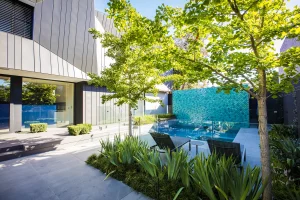Carpinus betulus ‘Fastigiata’ or European Hornbeam is a popular deciduous ornamental tree with a fastigiate growth habit. It has green leaves that turn brilliant shades of yellow and gold in autumn. Fastigiate is a horticultural term, and it means that the tree has erect branches. Fastigiate trees are tall and narrow and therefore perfect for gardens with limited space. The leaves of Carpinus betulus ‘Fastigiata’ have serrated margins and are strongly veined.
How to Use
Carpinus betulus ‘Fastigiata’ is an ideal tree for avenue planting, hedging and can be used as a feature tree in smaller gardens. It can also be pleached, hedged or clipped to provide a screening alternative. In our Deepdene project, we had a larger space to work with, so we grouped the trees to create a statement amongst the gravel.
How to Plant
This tree prefers to be planted in well-drained, moist soil and in a spot that receives full sun. While this is their desired position, they are pretty hardy and would thrive in a part shade position. After planting, we recommend mulching around the planted area to ensure that the soil stays moist. You expect a Common Hornbeam to grow to approx—12 m tall and 4m wide.
Companion Plants
In our Deepdene project, we used the following plants alongside Carpinus betulus ‘Fastigiata’ trees:
- Persicaria affinis – Knotweed
- Salvia nemorosa ‘Lubeca’ – Meadow Sage
- Syzgium smithi – Topiary Lily Pilly
- Buxus semperveriens – Common Box
However, as this is a tree rather than a shrub, perennial, groundcover, climber or grass, you have a lot more freedom as to the plants you can plant alongside it.
Care and Maintenance
Carpinus betulus ‘Fastigiata’ is relatively low-maintenance and is tolerant of several environmental conditions, including air pollution and drought. It requires minimal pruning if cultivated as a tree yet responds well to heavy pruning if grown as a hedge.





